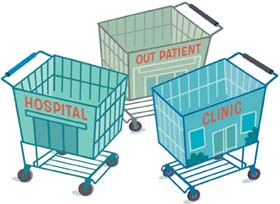 |
 |
| current issue |  | past issues |  | send a letter/news |  | address update |  | advertise |  | about us |  | alumni home |
|
Inquiring Minds By David Brooks and Kristen Grieco Illustrations by Jim Paillot |
Easy to print version |
In this issue:
Art NouveauCost Surgery
Rural Mural
Also read the long version of Inquiring Minds
Art Nouveau
Kids learn more than drawing with tablet PCs

|
Parents who have to erase toddlers' scribbles off the walls of their house know that kids love to draw. Ongoing research has found this applies even when the "pen and paper" are digital—tablet computers, for example—a finding that could give preschool teachers a new tool in the classroom.
"We found that kids created at least as much detail, if not more, in their drawings on a tablet as with traditional media," says Leslie Couse, associate professor of education and coordinator of the early childhood graduate program. Even when children encountered glitches on their tablet computers—and what computer user doesn't encounter glitches?—they charged ahead. "Over time, the number of glitches increased—the kids got more sophisticated in their uses—but there wasn't an increase in frustration. They persisted, and took it to new levels," she says.
After being handed a tablet PC in 2006 during UNH's Faculty Instructional Technology Summer Institute, Couse became intrigued with the possibility of using stylus-controlled computers in early education, since a keyboard or computer mouse can be a major obstacle for young children. She and Dora Chen, assistant professor of family studies and associate director of the UNH Child Study and Development Center, set up a "learning center" at the center, featuring two tablet PCs. Using interviews, assessment tools like the "draw-a-man test" and videotaped sessions, they oversaw children's interaction with the tablets to see how feasible they were in a real-world classroom.
Not only did the kids not destroy the computers, Chen says the kids found unexpected benefits, such as the fact that the tablet could erase better than a pencil—no smudges!—and had colors like a marker. "Pencil erasing is a big thing—it leaves a mark and is actually pretty frustrating. The tablet makes it easy; they loved it," she says.
Loving something and learning from it aren't always the same thing, of course, but Couse and Chen say their study of 41 children over a period of time found few drawbacks, aside from cost. The excitement of new technology provided more than enough motivation to overcome any distraction, while the added complexity was often a bonus, because the children enjoyed showing each other how to make the tablet work. "Particularly for young children, when you put computers in a learning center, there's an increase in language, in social interaction. Put two (computers) side by side and it's a good way to build children's language skills," Couse says.
This resea rch, to be published later this year in the Journal of Research on Technology in Education, has drawn accolades. Couse and Chen were awarded the 2008 Technology Leadership Award by the National Association of Early Childhood Teacher Educators, and received a fellowship for technology leadership at the Society for Information Technology in Teacher Education Conference. But they say it's only a start: While they believe they have demonstrated that tablets can play a useful role in early education, the next level of research will involve determining specific ways teachers can use tablets.
"We would never suggest that it replaces traditional things that happen in early childhood or preschool classrooms, but it is one more tool for teachers to be able to use to motivate children in the learning process—a tool for teaching them skills," says Couse.
Cost Surgery
Collecting data on health pricing may lead to reform
Do you want an outpatient mammogram in New Hampshire? You and your insurer will spend between $243 and $550, depending on which facility you use. How about an outpatient kidney-stone removal? Prepare to spend from $5,300 to $13,000.
Those numbers come from one of the most innovative health-care initiatives in recent years, born of work by UNH as well as the states of New Hampshire and Maine. It's a data-driven analysis of medical pricing that in its three-plus years of operation has not only opened eyes about the wide variation of prices for similar procedures but also provided a valuable tool for researchers.
Patrick Miller, a research associate professor with UNH's New Hampshire Institute for Health Policy and Practice, points to a recent patient migration study derived from the database. "That's one of the things it holds great promise for: We can very quickly get a sense of where patients go for care. This level of information is important for health-care reform," he says.

|
Like much academic research, the migration study created new questions even as it provided answers. For example, it found that Coos County loses roughly 70 percent of its hospital market to facilities further south. While that's to be expected to some degree, since not all services are provided at all facilities, especially at small, rural hospitals, it still raises a question about whether it's a positive or negative trend.
In the last few years, the system has accumulated a vast amount of data from insurance payment records. "The back-end processing to build the database is fairly straightforward, but needs rigorous attention to detail," says Miller. (That job is contracted out.) "The analytics, that's difficult. Good data analysts and statisticians are extremely hard to find, and understanding health-care claims data can be a special challenge."
The creation of Health-Cost (www.nhhealthcost.org), the online medical costcomparison site, has also been relatively straightforward. The tool allows patients and employers to comparison shop for prices—something that policymakers hope will force providers to hold down expenses. (A version for USNH employees has been created as well.) Using this massive database for detailed academic-level research into the way our patchwork health-care system works will be harder.
To make such research possible, UNH hosts a council, made up of national researchers, policy makers, health-care officials and representatives from states and health-care plans, to create standards for databases that are being built in other states. Their work sounds unexciting—harmonizing data collection rules and integrating Medicare information are high on the to-do list—but is drawing a lot of interest. "I hear from folks from academic institutions, policy think tanks and industries," says Miller. Not as eye-catching as exposing the cost differences between hospitals, but in the long run, it too might help improve America's health care.
Rural Mural
A survey reveals four distinct rural categories
Rural America: rolling hills, cows grazing on green grass, farmers making their living off the land. For the 50 million people living in small towns and rural communities, these stereotypes are outdated. (In fact, 94 percent of them make their living at something other than farming.) That's why researchers at the Carsey Institute are redefining rural.
"America is no longer a nation of small farms," says sociology professor Larry Hamilton. "The changes that are obvious in cities are paralleled in places that we might picture as unspoiled."

|
"Place Matters: Challenges and Opportunities in Four Rural Americas" is the result of a 2007 survey by UNH's Carsey Institute of nearly 8,000 residents in 19 rural counties. Researchers surveyed a variety of areas and found the differences were stark.
In the amenity-rich Rocky Mountains, postcard-worthy landscapes draw an influx of newcomers that have swelled the population 71 percent over 15 years. The survey found high employment rates, low poverty levels and residents who are environmentally aware and largely in favor of conservation laws.
In resource-dependent areas of the Midwest, the young adult population has shrunk by half. There, the industries on which rural residents relied, like mining and timber, are depleted, and manufacturing jobs are increasingly outsourced.
Chronically poor counties of the South, where up to 30 percent of the population is poor, also face a population drain, and residents there tend to take a dim view of environmental rules that restrict development. They're evenly split whether to conserve resources or to use them in creating new jobs.
A fourth, hybrid area emerged in the study: the amenity-decline areas of the Northwest and Northeast. These areas, long dominated by industries like paper and pulp, are looking to other industries to create jobs as natural resources wane.
"To me, the amenit ydecline areas are the most interesting," says doctoral candidate Chris Colocousis '03G, one of the study's authors. "They've historically been dependent on natural resources and are transitioning to something else. It represents a whole new relationship between communities and their environments."
The "Place Matters" report was the first in a series of four surveys of rural America. Subsequent sur veys have delved deeper into the issues that surfaced in the original report. One thing that began to jump out at researchers is how much the environmental issues they were examining had become politicized. The pattern appeared in a recent sur vey of coastal Maine residents, and will be studied further in an upcoming survey of coastal Washington state.
"Back in the '70s, issues like environmental protection were bipartisan," Hamilton says. Recent surveys indicate "a partisan division, even on local issues. That will make it harder to solve local problems." ~
blog comments powered by Disqus

